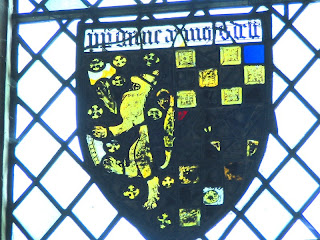Laurence Barber has a
webpage showing pictures of many of the coats of arms displayed in Fressingfield Church. He asks for help in identifying whose arms they are. This post gives details about the three which have a Brewes connection.

This first set is that of William de Brewes with his wife Elizabeth Hopton.
The explanation is:
Quarterly, 1 & 4 Brewes, 2 Carbonel, 3 Shardelowe...impaling Hopton.
William's great grandfather, Sir John de Brewes, married Joan, daughter and heiress of Sir John de Shardelowe. I'm not certain how the Carbonel arms were acquired but they are associated with John de Shardelowe whose mother may have been a Carbonel heiress.
Elizabeth was the daughter of Sir John Hopton, but not an heiress, so the Hopton arms were not added to the family's achievement.
William

Brewes' daughter, Thomasine, married Thomas Hansard and as an heiress, she carried the Brewes achievement to the Hansard arms.
This second set is that of their son Anthony Hansard, who married a daughter of the Lovells of Norfolk.
Here we have:
Quarterly, 1 Hansard, 2 Brewes, 3 Carbonel, 4 Shardelowe...impaling Lovell.
Again, the Lovell wife was not an heiress so the Hansard achievement was not augmented and their son carried the same arms.
Anthony Hansard

died on 5th August 1517 and the wardship and marriages of his children was granted to his uncle Roger Townshend. Roger sold them on to Thomas Skipworth (or Skipwith) of Utterby. This third shield marks a marriage which resulted from this.
The arms show Hansard as before, impaling Skipwith.
Giles Hansard, the heir of Anthony, was married to Jane, the daughter of Thomas Skipwith.
The manor of Fressingfield had been a long-running cause of dispute between the Townshends and the Hansards which had been settled by Anthony. Giles was able to pass it on to his daughter Katherine who married Thomas Rouse.
The whole story of these three sets of arms is illustrated in the pedigree below.

 e about the arms represented in this shield displayed in the window of Wiston church in Sussex. It has usually been described as Brewes impaling Clifford which would imply the existence of an Anneys de Clifford with a Brewes as husband. However, the glass in the window only gives a slight indication of the "fess gules" which would be needed on the field "checky or and azure" to confirm the Clifford connection. There are several other sets of arms which could easily fit the present observed state of the glass.
e about the arms represented in this shield displayed in the window of Wiston church in Sussex. It has usually been described as Brewes impaling Clifford which would imply the existence of an Anneys de Clifford with a Brewes as husband. However, the glass in the window only gives a slight indication of the "fess gules" which would be needed on the field "checky or and azure" to confirm the Clifford connection. There are several other sets of arms which could easily fit the present observed state of the glass.



